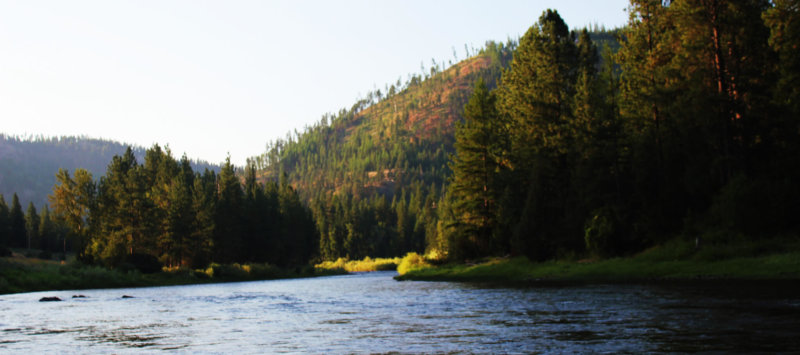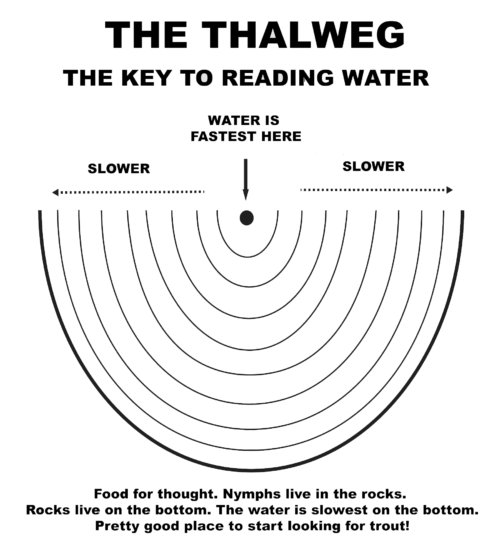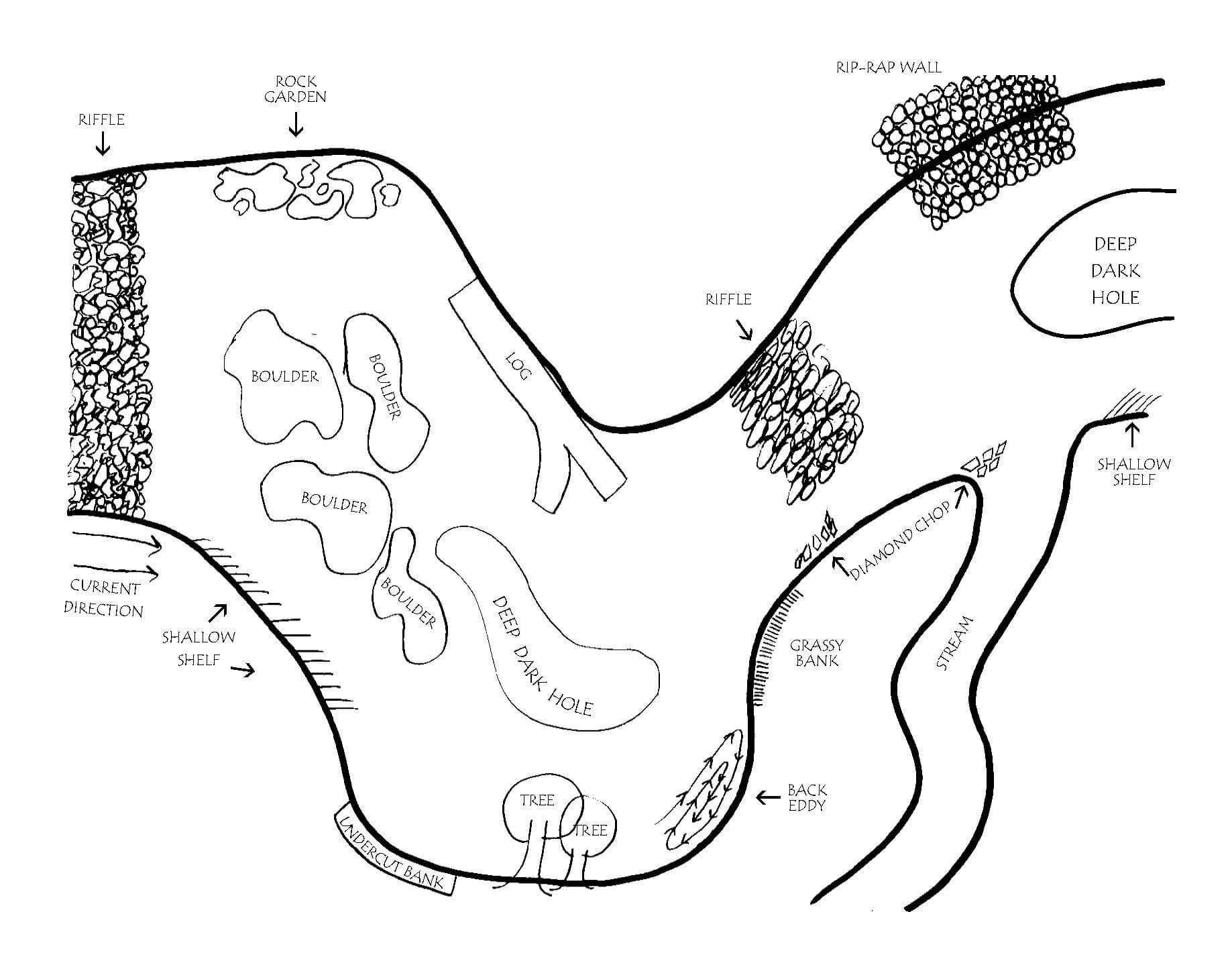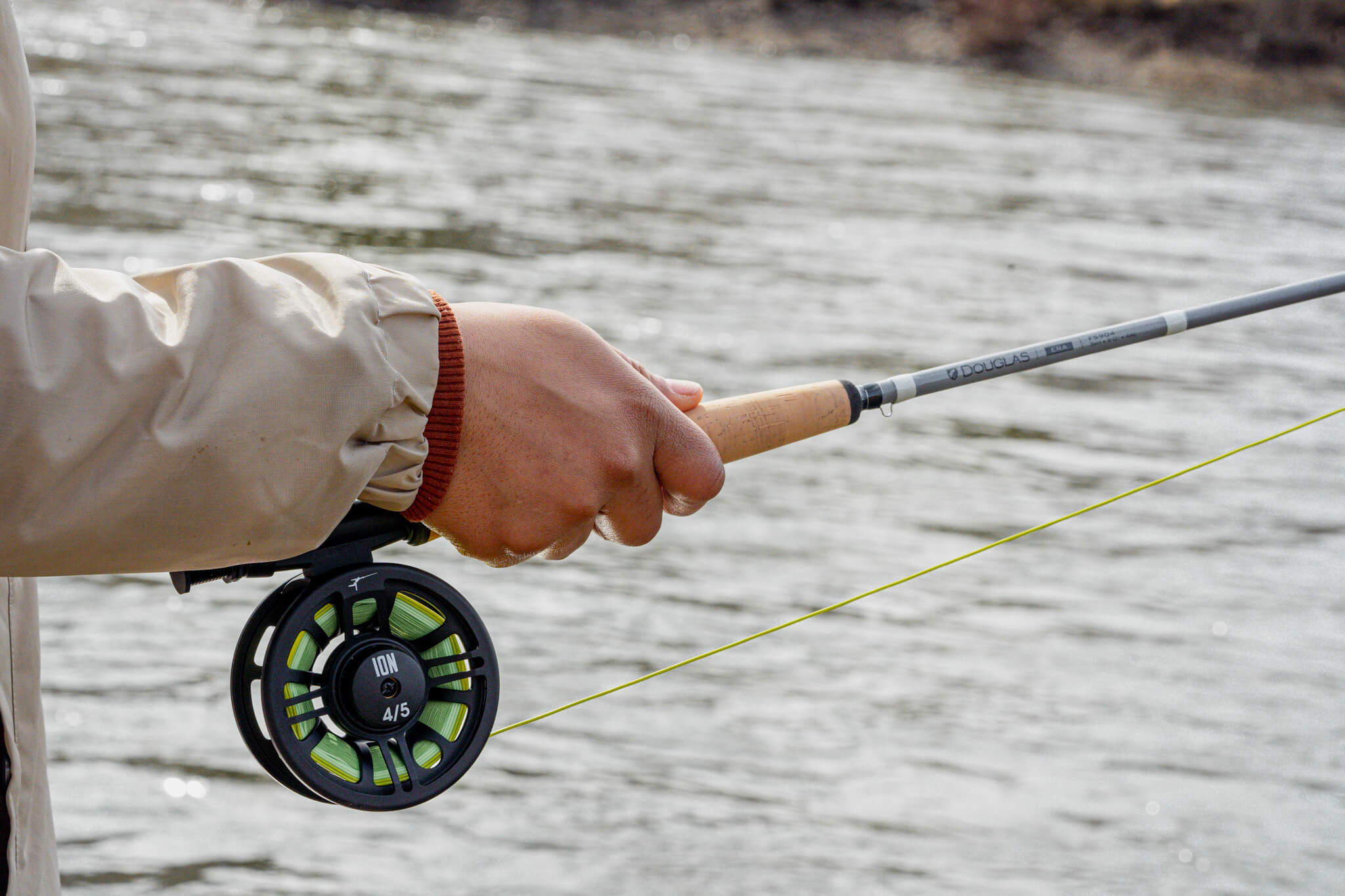Reading The Water

To many trout anglers, rivers are magical. They’re a place to recharge, located in areas of intense beauty and amazing vistas. Many anglers have spent time simply staring at the water, imagining the possibilities lurking beneath the surface. Staring at the water, interpreting the information every river provides. The river tells a story, and the experienced angler is reading, building mental images based on many clues and markers. Predicting where and what the trout are doing, as they interpret the sweep of the bends and the shape of the currents.
That’s reading the water to find the trout. An angler is a predator, simple as that. A good predator searches his surroundings for likely spots to hold their quarry. It pays to know about trout- what they need to survive and how they interact with their environs. It’s smarter to know about what your quarry eats! Animals go where the food is. More on that later.
As you look at a river in the early stages of your learning to fly fish adventure, start with this analogy. The river is a conveyor belt of food. In moving water, trout remain mostly stationary, while the river brings food to them. Trout ALWAYS face into the current (not always upstream, but into the current. There’s a difference) and eat what the river delivers. This is in direct contrast to still water, where trout move to find food that tends to be much more stationary.

To understand the river as conveyor belt, you need to know about the thalweg. The thalweg is where the water is moving fastest. If you’ve ever waded in a river, you know the thalweg, even if you didn’t know it had a name. In most river sections, the water moves slowly on the edges, and faster as you approach mid-river. Look at the drawing of the thalweg. The fastest water is at the top, in the middle. The slowest water is along the edge and the bottom.
This is important when we think about the trout as a calorie calculator. Let’s do some fish math!
Imagine bugs floating on the surface of the river, spaced out 1 per foot. At the thalweg, the water is moving at 10 feet per second. That means 10 bugs go by every second, 600 per minute, which is a lot of food. Now imagine the river’s edge, where the water is slowest. It’s moving at an inch per second. One bug every 12 seconds, or 5 per minute. Not much food. Seems a no brainer where the trout are- where the food is.
It’s not that simple. Fast water requires a tremendous amount of energy to hold position. Can a trout take in enough calories to grow and offset the energy expended to stay in the thalweg? Conversely, while almost no energy is expended at the edge, are there enough calories in 5 bugs per minute to survive? The angler’s job is finding the place in the river where the water is moving slowly enough for the trout to hold position, but fast enough to provide enough food to thrive.
It gets better. Factors change with the size of the fish and temperature of the water. Bigger fish require more food to maintain their size, while expending more energy to hold a bigger body in position. Smaller fish require less food and less energy for position maintenance. Smaller fish have many more places in the river where they can survive.
Trout are cold blooded. Their metabolism rises and falls with water temperature. In cold water, trout need less food and are found in slower water. With warmer water, metabolism rises and trout need more food. Trout seek out places with more food, often locating where the water (conveyor belt) is moving faster (providing more food). A trout’s metabolism is maximized at 63 degrees, and stressed at 70, to give a concept of what’s meant by warm and cold water
It gets more better! No trout river resembles the stylized U in the thalweg diagram. There are curves in the river, logs, boulders, ledges, strainers and lots of other structure that affects flowing water. The river changes width, changing the water speed. Gradient changes along the length of the river, affecting current speed. All these factors play into where trout will be in the water. The stylized thalweg of the drawing is not as easily located in a wild river.
WHOA! You’re wondering how anyone ever even finds a trout, much less catches one. It’s not as hard as it looks. Remember the three things trout look for- food, safety from predators and a haven from the current. It’s not as hard as it sounds.
For those who have spent time by a river, this may seem basic, but it needs to be said. Light colored water is shallow, darker water is deeper. You know that from wading or playing in a river. If you can see the bottom, the water is relatively shallow. If the water is dark enough that the bottom is indistinct, the water is deeper. First rule of reading the water.
Water is one of the densest materials on earth. If there’s a rock on the bottom, the surface will reflect that, to a point. In shallow water, the surface can be very uneven due to bottom debris. The water on the surface reflects the shape of the bottom underneath. Go a little deeper, and the surface bumps become more subtle. In 4 feet of water, a 1 foot tall rock may only provide a 2 inch bump on the surface. But the bump is there, to be read by someone looking for it. As water deepens, the bottom becomes less distinct and readable from the surface.
Light and dark water, bumpy and smooth water, it all tells a story to an accomplished water reader. Now, we have to figure out how trout relate to the bumps, light and all the other things the water is trying to tell us.
Trout are very simple. They spend their lives doing 3 things. Eating, not being eaten, and in their time, making little trout. They have a measured IQ of 4, which is far from genius level! Don’t tell anyone. Do you really want others knowing you couldn’t out-smart an animal with an IQ consisting of fewer fingers than you have on one hand?
Because of this limited capacity, trout can only do one thing at a time. If they’re feeding, they’re not spawning or fleeing. If they’re fleeing, they’re NOT eating! When they’re spawning, they’re not eating or fleeing. The trout is single minded.
Let’s examine each thing the trout needs to survive in the water.
Food
We know the river is a conveyor belt, and the faster the river goes, the more food goes by. That’s simple math. Food is the easiest of the three concepts to understand. We discuss food on the surface because it’s the simplest way to understand it.
Most trout feed subsurface most of the time. The same concepts are valid in all levels of the water column. If the water moves rapidly on the surface, it moves rapidly underneath as well. Not as rapidly- remember the drawing of the thalweg and water slowing down as it gets closer to the bottom- but relatively rapidly. The water’s surface is almost always a mirror of what’s going on underneath. While the conveyor belt concept is easily understood on the surface- the trout are usually beneath the surface.
Protection from Predators
Protection comes in many forms to trout, but in almost all cases, they’re protecting themselves from predation from above. Eagles, osprey, falcons, humans, herons, raccoons, bear- whatever comes at a trout from land comes at them from a position higher up than they are. The first protection from overhead predators is something solid over their heads. Tree branches, an undercut bank, over hanging grass, this structure obscures a trout from vision to overhead hunters. However, it’s a rare spot that provides overhead protection, food and structure.
The best defense against overhead hunters is water depth, for two reasons. The first is the reach of the predators arms, talons or claws. It takes a mighty big bear to dig its claws 5 feet deep in a river! Raccoons work in a depth of 3-12 inches. Osprey and eagles can go fairly deep, but the noise and vibrations created entering the water are a warning to trout two feet beneath the surface. You’ll often see an osprey come up empty-taloned after a dive.
Depth also obscures the trout from vision. As you learn to fly fish, you learn to see trout in the water. They’re a lot easier to spot in shallow water! The shadow on the bottom is more pronounced, the bodies more visible in the higher light areas. Depth equals safety to a fish. Why do you find trout in shallow water? It’s a risk/reward proposition. Photosynthesis occurs in shallow water. Due to that, shallow water is home to more food. Additionally, if a trout lies in 2 feet of water, it’s easier to patrol the entire water column, moving up or down to take in food. When trout lie in 4 feet of water, more energy is expended to move up or down. It’s not worth the energy expended versus caloric intake. If you ever decide to go night fishing (very exciting, and it’s when the BIG fish come out to play) you’ll find 5 lb fish in 8 inches of water! They’re there because nothing in the water column gets by. They can do this because very few predators come out at night, and the darkness conceals the trout.
How ingrained is the flight instinct in fish to flee from danger above? Spotting planes must be very careful not to throw their shadow across schools of 900 lb tuna, or they will sound straight to the bottom of the ocean. There hasn’t been anything big enough to swoop down and eat a tuna since the Cretaceous Period, but still, giant tuna flee from a shadow. Keep that in mind as you approach a river- fish are very adept at fleeing from danger above.
Structure
Structure is everywhere in a river, and means different things to different sized fish. A 4 inch trout can hold behind a 1 inch rock in a riffle and be out of the current. It feeds well, and grows. Soon it no longer finds shelter behind the now too small rock, and must move to find somewhere providing a current break for a bigger fish. This continues for the lifetime of the trout. The more it grows, the larger the structure must be. Fish are certainly water-dynamic, meaning they’re designed to create minimum resistance to current. Still, bigger fish create more resistance, and they need places where they can be protected from the current.
Certain structure will also provide protection from predators. An overhanging tree branch, a root wad or a log in the river provides overhead protection as well as a current block. Structure covers a lot of bases when applied to a river.
Putting it all together
Trout are looking for food, safety from predators and a current buffer. Ideally, they find all three in one spot. A perfect example is a boulder in the river. As structure, it breaks up the current, providing shelter. The boulder acts as a funnel for all the food that pushes up against it, moving the food to the side of the boulder and channeling it close to the edge. The trout stay in the current break, slip into the current to feed, and move back into shelter.
Water is a very powerful force in nature. Water moves earth, rocks and trees long distances. If you dig deep enough in the Clark Fork or Bitterroot valley, you find where the river has ranged across the entire valley in some spots. Rivers shape the ground they move through.
This helps explain why boulders are so good for holding trout. As the water cascades over and around the rock, it is shaping both the rock and the terrain around it. Water doesn’t just move horizontally in a river- structure forces water up and down as well. Just behind boulders, the river has dug out a nice deep trench for the fish to rest in and feel safe from overhead predation. It’s a perfect place for a trout to be, and many call it a prime lie.
Boulders are only one example of a prime lie. Wherever food, safety and structure come together, you will find trout. Prime lies vary with fish size. Smaller fish require less obstruction, and less food. There are more places fitting that description, and many more small trout than large trout in a river.
To sum it up, you’re looking for structure (breaks in the current) combined with safety from predators and an abundant food supply.
Click here to go to the map of prime lies.
There are other aspects of reading a river as well. When you approach a river, look at the bank. If the bank is sheer at the surface, you can be pretty sure the bank continues to be sheer below the surface. If the slope is gentle to the surface, most times the gentle slope will continue below the surface. You can use the color of the water (light or dark) to help with this assessment, but it’s rare for a gentle slope to turn sheer at water’s edge, and vice versa.
The sun is also a big factor in reading the water. When the sun is shining, trout feel much more exposed, because they are! Predators see deeper into the river, and trout that have survived have learned to be more careful in the sun. This enters into reading the water, as fish will change position (mostly depth) in differing lights.
Water temperature is also a factor. Colder water slows down a trout’s metabolism, allowing them to eat less. They can be in water that doesn’t seem prime. Warmer water puts more of a burden on a trout, and the prime lies become more necessary and competitive. Trout are NOT everywhere in a river! A 50 foot long riffle that gets no deeper than 6 inches doesn’t hold many catchable size trout. The stagnant water below a bend or along the edges in a slow glide won’t hold any fish. Shallow water is too exposed. Stagnant water doesn’t hold enough oxygen, nor does it provide food. There are so many places that don’t hold trout- don’t waste your time on fishless water.
All these factors enter in to where trout will be found. It’s a constant puzzle the angler has to solve every time they take to the water! Cold, hot, sunny, cloudy, high water, low water, it’s all taken into account. Each of these factors changes the trout’s behavior, and makes fly fishing the challenge it is.
The most important piece of angling equipment you carry is your brain! Many novice anglers will fish the same stretch of water over and over again, because they’ve caught a fish there. While time on the water is always a great learning experience, it’s important to look carefully at your favored waters and see WHY the trout are there. What are the characteristics of the water? And more importantly, are these characteristics found elsewhere on the river? In most cases, they’re found in many places.
While knowing your home waters like the back of your hand is a great tool for fishing, over time it slows down the learning curve of a novice angler. Once you’ve discovered the lie of a 16 inch fish (Yes, we said 16 inches. That’s a BIG trout! Carry a tape measure for a while, and don’t believe the guy with no pictures and tales of 20 inch fish!!) where you always fish, take your game to a different area and see if you can duplicate that situation elsewhere. That’s really how you learn to read water, going somewhere new and taking what you’ve learned on the road.
Trout are trout all over the world. You know what they need to survive. You know what to look for in the water, what characteristics are required to hold fish. It doesn’t matter if you’re in the high mountains of Tennessee, the limestone streams of Pennsylvania or the roaring freestone rivers of Montana, Argentina and beyond- trout are trout. 20 inches is big wherever you go. They all need food, protection from predators and structure. It doesn’t matter what hemisphere you’re in, trout need those things. If you can find trout in New Hampshire, you can find them in California, Minnesota, Chile and Alaska.
Look at it this way. You’ve found one 16 inch fish, so you know what a prime lie for 16 inch fish looks like. There are more of those places up and down the river! It pays to do a little exploring to find new haunts for fish. It will quickly up your skill set, looking at new water and trying to solve a new riddle. We’re not saying never go back to that favored stretch, just to branch out a bit to keep your skill set growing. Keep that 16 inch fish in your back pocket, for when it’s important to go out and catch one (that will make more sense the longer you fish!).
Here’s another thought. You don’t know-YET- where the 20 inchers live! Don’t you want to go and find out?!


